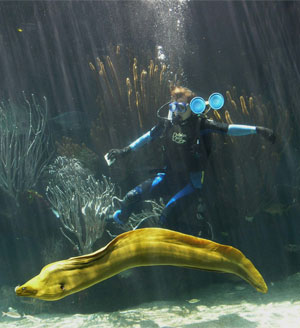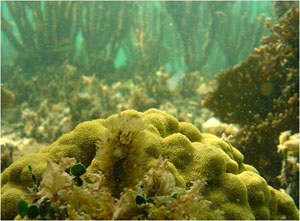 |
| Julia Lawson, here with Casper the moray eel, becomes part of the North Rock exhibition at the Bermuda Aquarium Museum and Zoo. (Photo courtesy of Julia Lawson) |
Talk about a Kinder Surprise: part of Julia Lawson’s job at the Bermuda Aquarium Museum and Zoo entailed filling plastic eggs with shrimp for octopuses.
“I didn’t realize until coming here, but octopuses are extremely intelligent,” says Ms. Lawson, 21, a biology honours major who did her science co-op placement at the Bermuda Aquarium Museum and Zoo and is now doing research at the Bermuda Institute of Ocean Sciences. “They’re able to open the eggs with their tentacles and extract the shrimp.”
Octopuses are an evolutionary oxymoron: big-brained invertebrates that display many cognitive, behavioral, and affective traits. They have sharp eyesight and use the suckers on each of their eight arms to feel and to taste.
The concept that an octopus could be trained was news to the 21-year-old Haligonian six months ago. But everyday was a learning experience at the aquarium: other tasks included making a mini-weight belt for a disabled Hawksbill Turtle which was rendered permanently buoyant and couldn’t settle on the bottom to forage, feeding the marine animals and cleaning the North Rock exhibition, a 530,000-litre replica of a living coral reef off Bermuda’s north shore. The 4.5-metre-deep tank is home to sharks, barracuda, schools of pompano, golden-frilled triggerfish, and Casper the moray eel – fiercesome because it can’t see or hear well and could inflict a nasty bite if it mistook you for food.
“The tank is so big, so basically the job is to dive in and scrub off the algae from the glass,” she explains. “There’s usually something that comes out to harass you.”
Moray eel scares aside, Ms. Lawson is thrilled with her science co-op program. “I feel like co-op gives me so much more confidence and ability as a scientist … you can go through your classes basically brain dead if you want to, but with co-op you have to put it altogether. It’s incredible how it builds on learning.
“But the program is what you make it: you’ve got to go out and find those opportunities.”
Since her placement ended, the fourth-year biology student has stayed on in Bermuda and is now studying coral reef reproduction at the Bermuda Institute of Ocean Sciences. The research ties into climate change and its detrimental affects on coral reefs, fragile and complex ecosystems which are under threat throughout the world’s oceans.
“By understanding reproduction and recruitment we can determine ideal conditions for corals and learn what normal development looks like. This information can also help us manage and protect coral reefs, through methods like reef restoration.”
 |
| Mustard Hill coral, or Porites astreoides. (Photo courtesy of the Bermuda Institute of Ocean Sciences.) |
Although they resemble plants, corals are actually animals living in individual polyps connected by living tissues. Each polyp has a cup-like shape with a ring of tentacles around a central opening that functions as both mouth and anus. The tentacles are tipped with stinging cells called nematocysts which corals use to defend themselves and to capture zooplankton for food. A coral colony is made up of many, many tiny polyps.
Many corals, such as the Mustard Hill coral that Ms. Lawson is studying, have single-celled algae called zooxanthellae that live in their innermost tissue layer. Both the corals and the zooxanthellae benefit from the arrangement: the algae use the sun’s energy to convert carbon dioxide from the seawater into energy-rich sugars and fats and the coral animals use that food to grow and produce their skeletons. The zooxanthellae also give the mustard hill coral its deep yellow color.
But as larvae, they’re tiny corals without a skeleton. Ms. Lawson describes them as little moving balls just a half millimeter in length—“like puppies looking for a place to lie down,” she says about coral settlement. The corals disperse their larvae in the night, when they’re not susceptible to UV damage from the sun and predators are less active. The larvae then search out a reef to attach to where they can settle and grow.
At the Bermuda Institute of Ocean Sciences, Ms. Lawson, under the supervision of Samantha de Putron, is raising colonies of corals. Like a mom with a newborn, it’ll soon be her turn to awake every three hours through the night to collect the larvae the corals produce and raise them in aquaria to assess fitness differences between the time periods of release.
“I thought they’d be more boring than they are,” she confesses, “but they’re actually super neat .... The corals are the backbone of huge ecosystems—it’s ridiculous how much fish diversity and marine life they support.”
